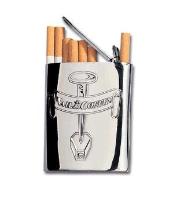Coffin Nails - TheCharlieWarnerReport

I remember when in the late 1950s, after Surgeon General Leroy E. Burney declared it the official position of the U.S. Public Health Service that the evidence pointed to a causal relationship between smoking and lung cancer, that one of my best friend’s mother, a heavy smoker, kept her cigarettes in a ceramic box labeled “coffin nails.” I smoked at the time (I stopped when I was 30) and laughed along with her at our guilty pleasure. She lived to be 83, and she didn’t die of lung cancer.
In 1957 neither the Surgeon General nor my friend’s mother could have imagined that 50 years later the city of Paris would pass laws banning smoking in restaurants.
Scotsman James Watt patented the steam locomotive in 1784 which eventually powered the growth of railroads in America and Europe. Neither Watt nor the railroad industrialists could have imagined that 80 years later railroads would enable artists to easily leave their studios in Paris and travel to the countryside to paint en plein air and create a revolution in art called Impressionism.
The first handheld mobile phone to become commercially available to the U.S. market was the Motorola DynaTAC 8000X, which received approval in 1983. Mobile phones began to proliferate through the 1980s with the introduction of "cellular" phones based on cellular networks with multiple base stations located relatively close to each other, and protocols for the automated "handover" between two cells when a phone moved from one cell to the other.
In 1983 neither the FCC nor Motorola could have imagined that cell phones would lead to wireless technology that would allow people to connect to the Internet and eventually enable consumers to by-pass local television stations and cable systems to get their favorite TV programs (commercial-free, subscription-based “Wired” or commercial-laden, free “Lost”).
My previous blog, titled “Bang, Bang, Bang” received comments which opined that Wal-Mart’s taking the New Yorker off its racks was not a particularly devastating nail in the coffin for the New Yorker specifically or magazines in general. Those who commented are correct in the short term – the New Yorker will probably live on regardless of Wal-Mart’s decision, but whether its life is in an expensive-to-produce-and- mail print edition or on the healthier, smoke-free Web is another question.
The point I was trying to make is that printed and either mailed or store-bought magazines’ health is in peril in the long run, and Wal-Mart’s decision was a just another nail in printed magazines’ coffin or, perhaps I should say, in their eventual demise as paper-based dinosaurs.

